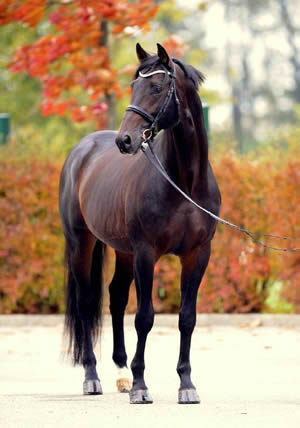History
The Trakehner, known for its friendly temperament, intelligence and athletic ability, is one of Germany's oldest warmblood breeds. King Frederick Wilhelm I of Prussia wanting his soldiers to have reliable transportation that was faster, sounder and more enduring than that of his contemporaries established the breed in 1732. For that purpose he opened a royal stud farm at Trakehnen in East Prussia. He used small native mares, called Schwaike, and crossed them with Thoroughbreds from England and with purebred Arabians. Throughout the years, the king's stud directors tried various other breeds but soon limited themselves to the Thoroughbred and the Arabian. The results of these crossings were exactly what the king wanted. Strict selection permitted only the best to breed while the "average" product was sold as riding horses, soon producing a distinctive new breed.
Originally, any horse born at Trakehnen was called a "Trakehner" to distinguish it from the "East Prussians" produced by private breeders who bought mares from Trakehnen and bred them to Trakehner stallions. Since the end of World War II, when East Prussia and the Trakehnen stud ceased to exist, all horses with Trakehnen or East Prussian bloodlines have been called "Trakehners."
In 1945, some of the horses from East Prussia endured extreme hardships, pulling their owner's wagons with all the belongings they were able to take when the advancing Soviet army forced them to flee toward the West.
The only escape route available led over the frozen "Kurische Haff," a bay of the Baltic Sea between East Prussia and the West. Many did not make it, breaking through the weakening ice under the weight of their wagons. Less than ten percent of the horses in East Prussia reached the safety of West Germany. Others were taken as war booty by the Soviets and by the Polish government and became a significant influence on their native warmblood breeds.
In West Germany, at a time when things were still very chaotic and basic necessities were scarce, Dr. Fritz Schilke, the executive director of the East Prussian Stud Book Society, took it upon himself to locate all of the East Prussian horses that had made it to the West. In 1947, only two years after the end of World War II, Dr. Schilke succeeded in establishing the West German "Trakehner Verband" (breed association) and a Trakehner Stud Book that continued to document the breed. In those early days, many horses could be identified from Trakehnen only by the single moose antler brand on their right hip or as East Prussians by the double moose antlers on their left hip. Their papers then bore the notation " papers lost due to the events of war - identified as Trakehner by its brand."
After several West German generations of Trakehners, Dr. Schilke noted that the distinctive Trakehner type had remained unchanged even though the horses had been displaced from their native habitat and subjected to very different living conditions. This is still true today. The Trakehner is now being bred all over the world and wherever this is done in a controlled situation, with documented pedigrees and selective breeding, the same type - with some modifications for the changing marketplace - still exists everywhere.
In the years after World War II, many of the other German warmblood breeds used Trakehner stallions to refine their horses. Examples are the Trakehner stallion Abglanz used in the Hanoverian breed, or the stallion Julmond in Baden-W rttemberg. The Trakehner studbook, however, is closed to all outside blood except the Thoroughbred and the Arabian (including Anglo and Shagya Arabs).
In North America, the first documented importation of Trakehner breeding stock occurred in the fifties when Gerda Friedrichs of Keswick, Ontario, Canada, imported three stallions and a dozen or so mares. Soon after, stallions and mares were imported into Virginia, California and the Midwest. A busy trade developed in these horses and their progeny. In 1974, the American Trakehner Association was founded to keep track of the breed in North America. In 1978, the ATA, as it is usually called, signed an agreement of cooperation with the German Trakehner Verband, promising to breed Trakehners in North America according to the same selective breeding and performance testing principles that are practiced in Germany. As a result, the ATA was granted the use of the double moose antler brand, supplemented by an additional arc underneath, signifying that the horse so branded is an American Trakehner.






